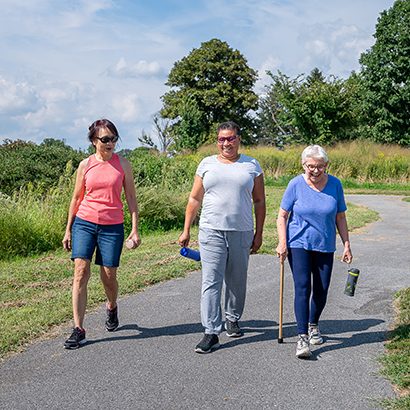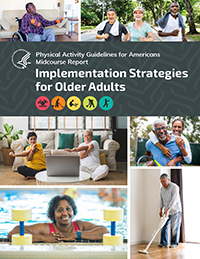
Older adults can reap many rewards from physical activity, including the ability to live independently longer, have a better quality of life, and need less medical care. Among all age groups, older adults have the lowest rates of meeting the recommendations in the Physical Activity Guidelines for Americans (Guidelines). As older adults continue to make up a growing share of the U.S. population, physical activity is a vital tool for helping them manage and improve their health. The Physical Activity Guidelines Midcourse Report: Implementation Strategies for Older Adults (Midcourse Report)highlights what works to increase physical activity among older adults. Park and recreation professionals can use these five strategies from the Midcourse Report to help older adults in their communities get moving.
1. Promote the benefits of physical activity.
Spread the word about the benefits of physical activity. The communications campaign for the Physical Activity Guidelines, Move Your Way®, includes free resources and tools — available in English and Spanish — that you can use to share the benefits of physical activity with older adults. You can display posters at community centers, hand out fact sheets at events, play videos with tips to get moving before an outdoor movie, or use the sample social media messages and graphics to promote physical activity on social media. You can also point older adults to the Move You Way® website, where they can learn more about physical activity and find ways to incorporate more movement into their daily lives.
2. Engage members of the community.
Hearing directly from older adults in your community will help you best meet their needs and ensure all people have access to and feel welcome at your programs and facilitates. Seek input from older adult community members when planning activities (e.g., needs assessments that identify safety concerns and other physical activity preferences). Consider engaging with people, groups and organizations most affected by inequities and disparities to improve your understanding of the reasons for these experiences.
3. Increase physical activity programming for older adults.
Consider how older adults fit into your physical activity-related programming. This can include specific exercise programming, like fitness classes, or other programming that gets people moving, like park cleanups. You can explore a list of Federally Supported Physical Activity Initiatives and Resources for Older Adults to find potential programs to bring to your community. Don’t forget to review, plan and implement programs with an equity lens to ensure they are inclusive for older adults of all backgrounds and abilities. Also, try emphasizing the social components of your programs to improve participation and retention. You can read how Detroit Parks and Recreation prioritizes camaraderie, connectivity and fun in its physical activity programs.
4. Create inclusive and accessible spaces for physical activity.
Consider the accessibility and inclusivity of your park and recreation facilities. Features like benches, public art, open gathering spaces, shade, landscaping, bathrooms, and safe and free drinking water can all contribute to perceptions of safety and inclusion. Wide sidewalks with sufficient lighting and no trip hazards, like cracks or overgrowth, can create safer and smoother paths for those who use wheelchairs and other assistive devices. Additionally, think about how the programming in the space can influence people’s feelings of belonging, safety and inclusion. If people see others who look like them in the space (i.e., representation), they may feel more welcome.
5. Lean on your partners.
When it comes to creating environments that support active aging, collaboration is key. Partners like aging coalitions, senior meals providers, health departments, transportation agencies and community-based organizations can help you better serve older adults. For example, transportation agencies can enhance public transportation opportunities to ensure parks and facilities are accessible to older adults with mobility, income and other limitations. Academic or public health institutions could help you evaluate community design policies, plans and projects. ACTIVE PARKS! Increasing Physical Activity through Parks, Trails, and Greenways includes information on how you can build partnerships to improve infrastructure and increase community engagement, programming and public awareness.
Everyone has a role to play in increasing physical activity levels among older adults. Explore the following resources for more information on how you can promote physical activity and active aging:
- Read the Midcourse Report and related resources.
- Find federally supported physical activity initiatives and resources for older adults.
- Explore Move Your Way® resources to promote physical activity.
- Check out the materials for older adults.
- Explore the Move Your Way® website for consumers.
- Join the Move Your Way® Campaign online community to discuss your efforts with other professionals.
- Learn about Active People, Healthy NationSM and evidence-based strategies to increase physical activity.
Leave a comment sharing how you’ve engaged older adults in physical activity and resources that have helped along the way!
Click the report cover to explore further!
Katrina Piercy,Alison Vaux-Bjerke,Malorie Polster and Bianca Macias work for the Office of Disease Prevention and Health Promotion (ODPHP) within the U.S. Department of Health and Human Services (HHS).


